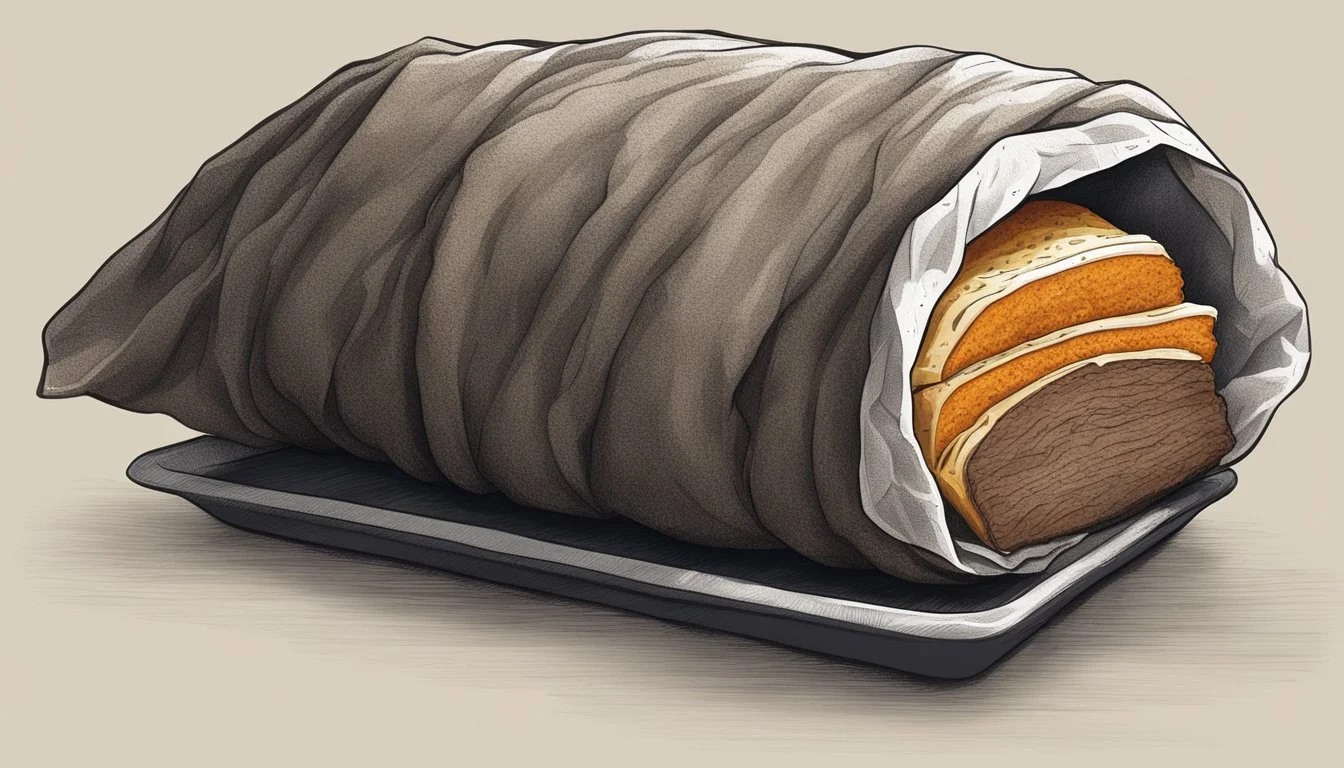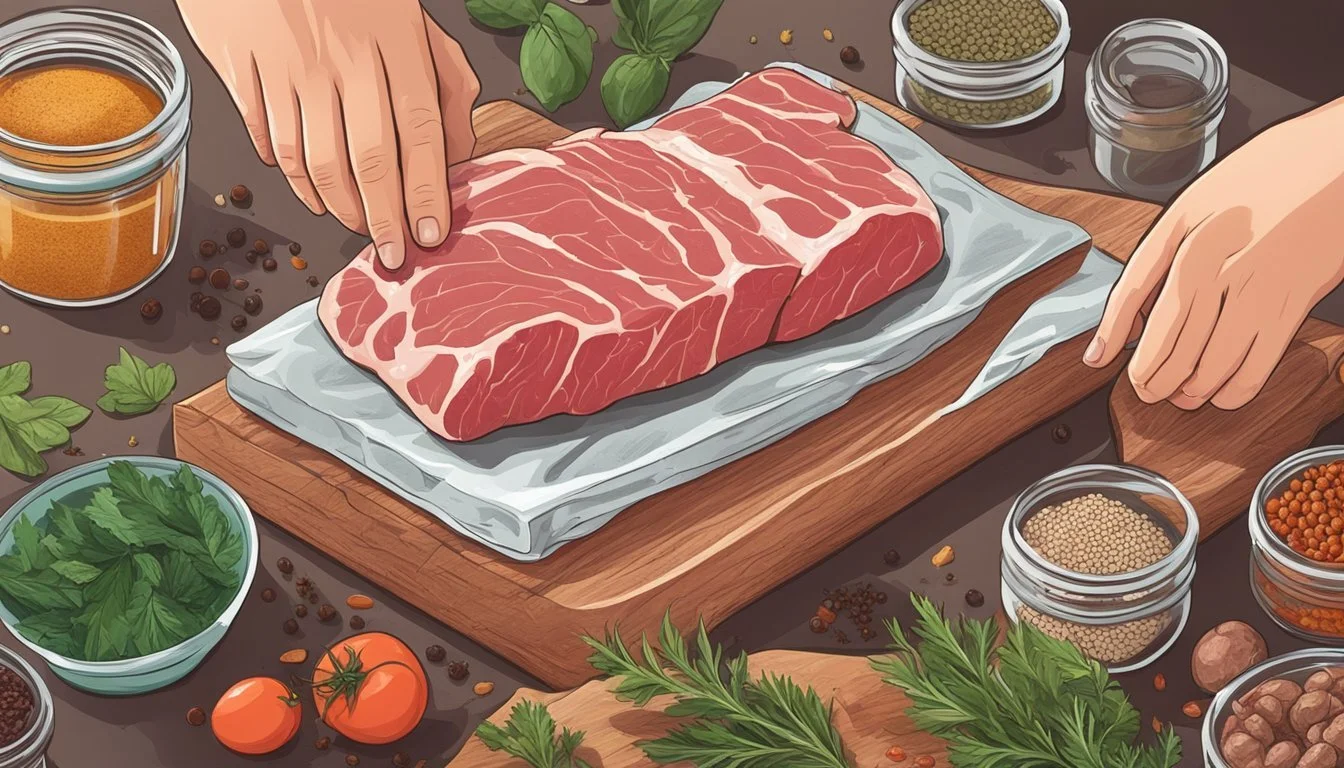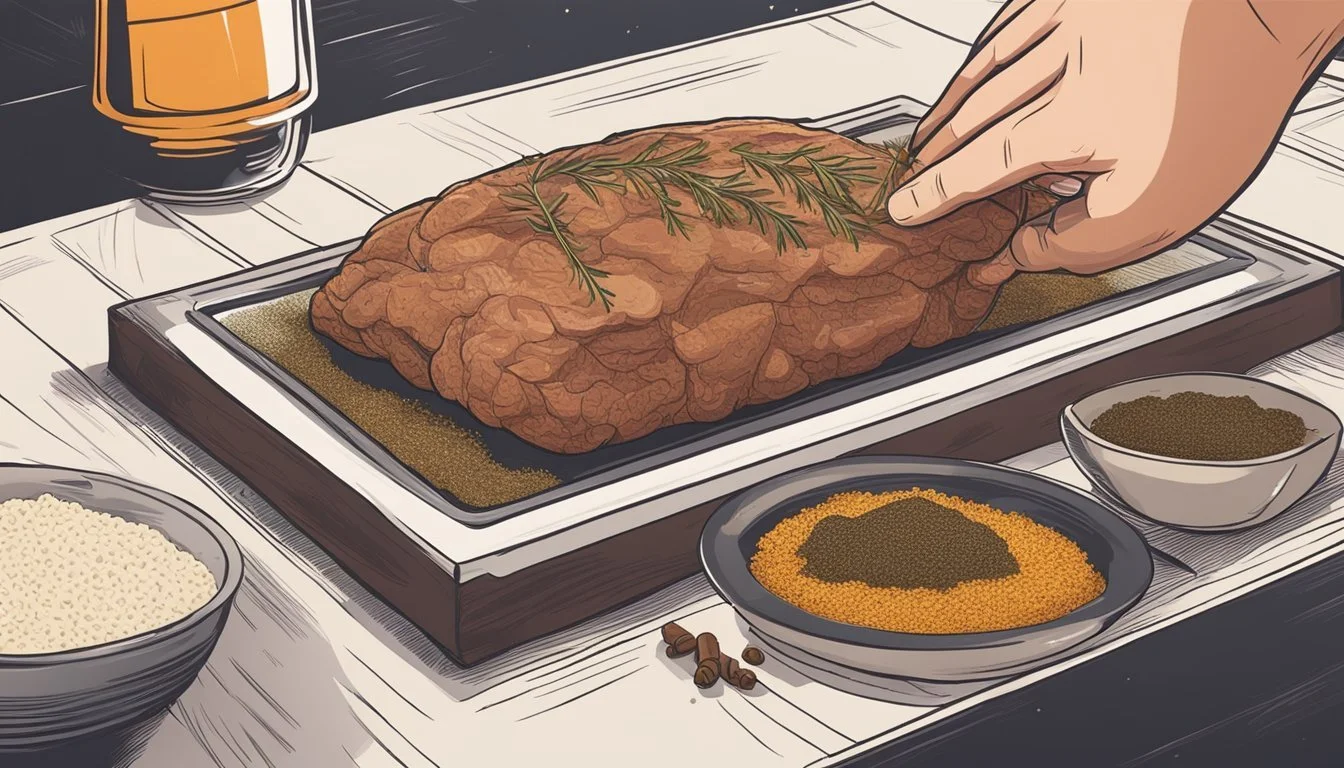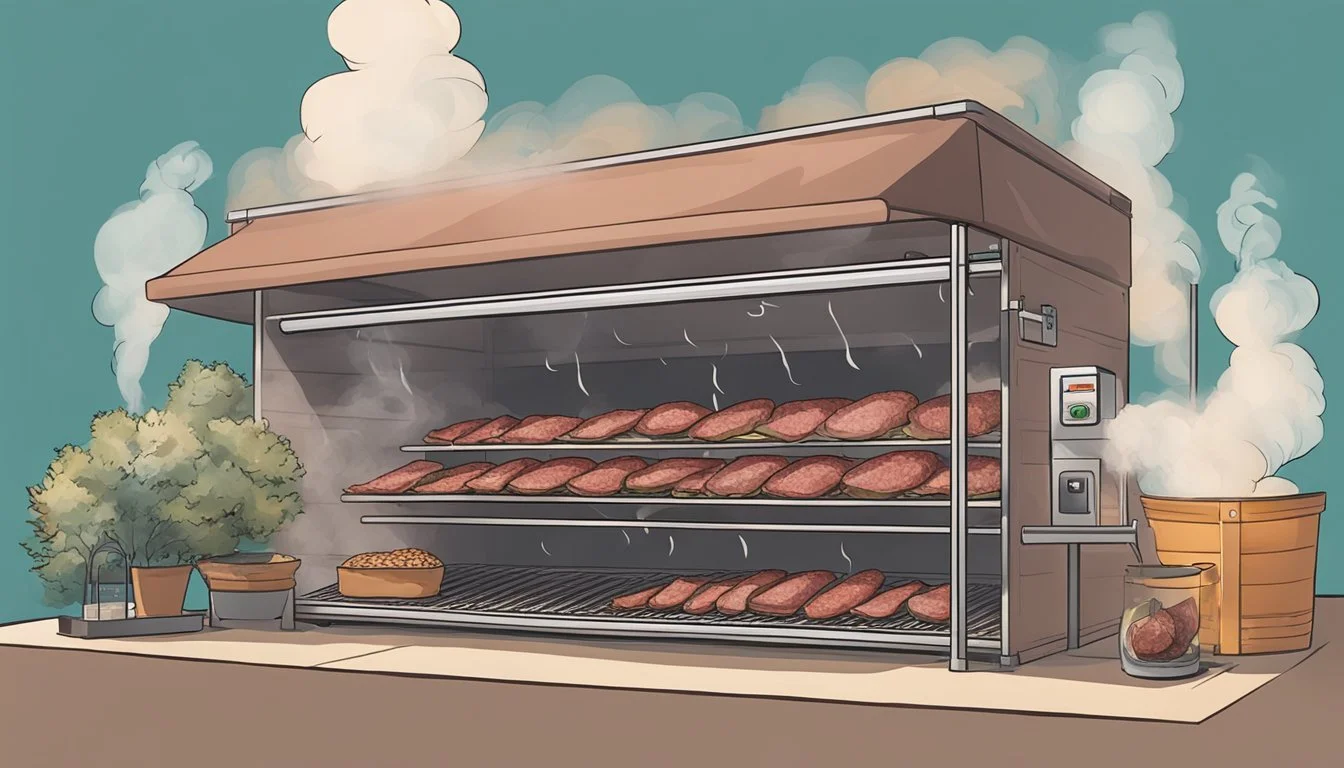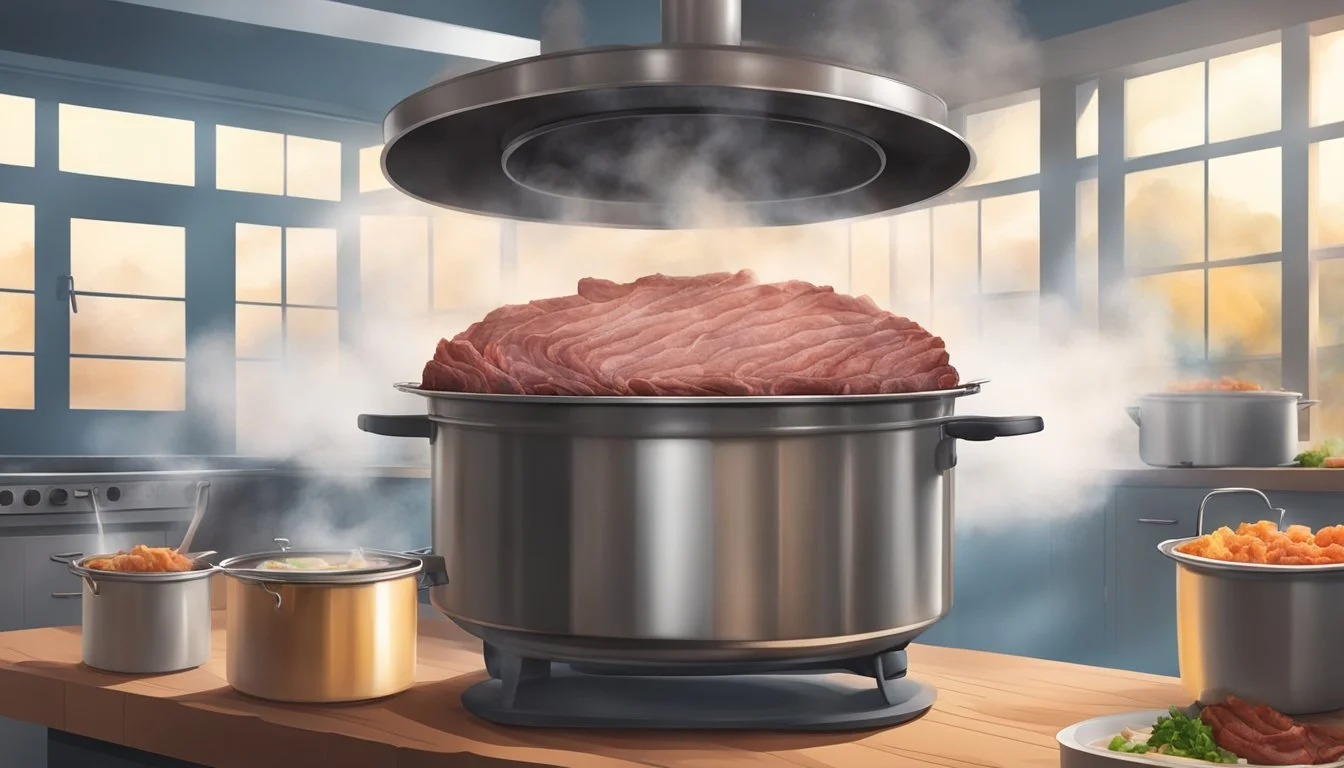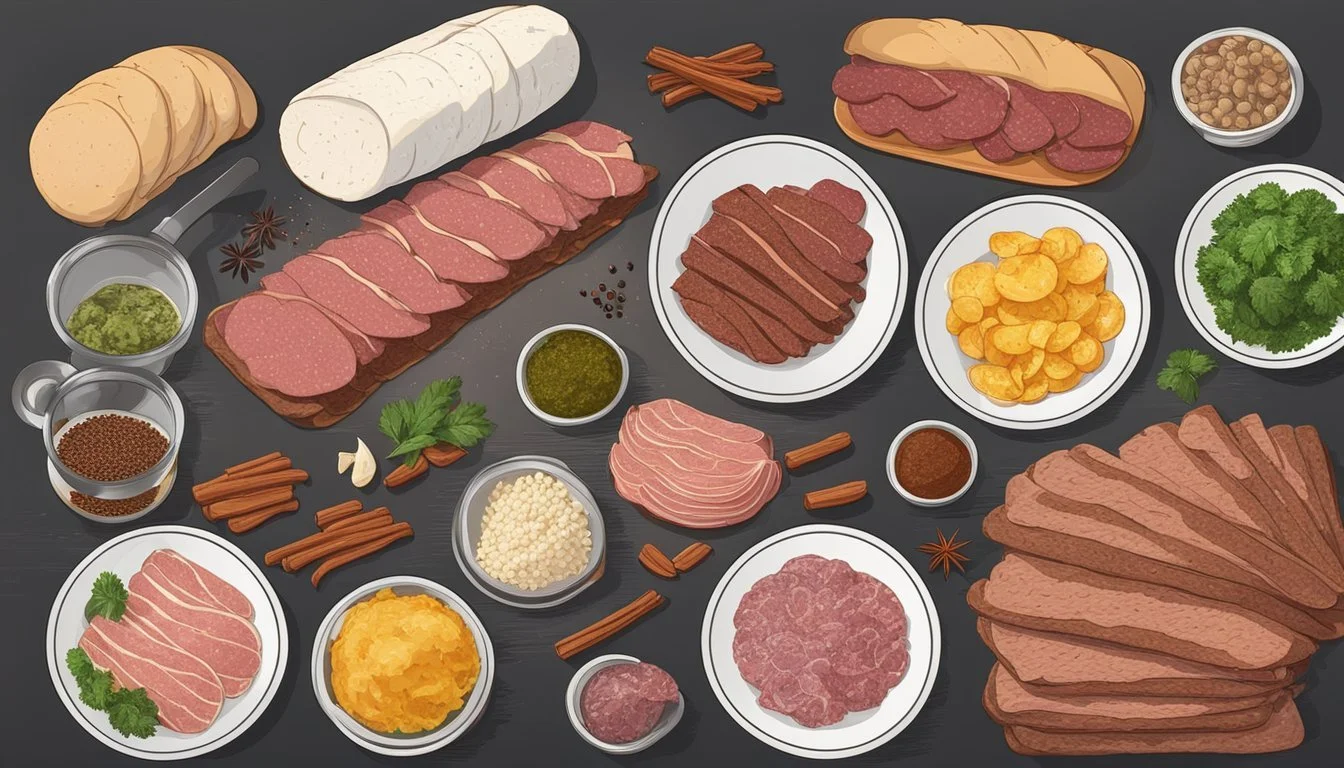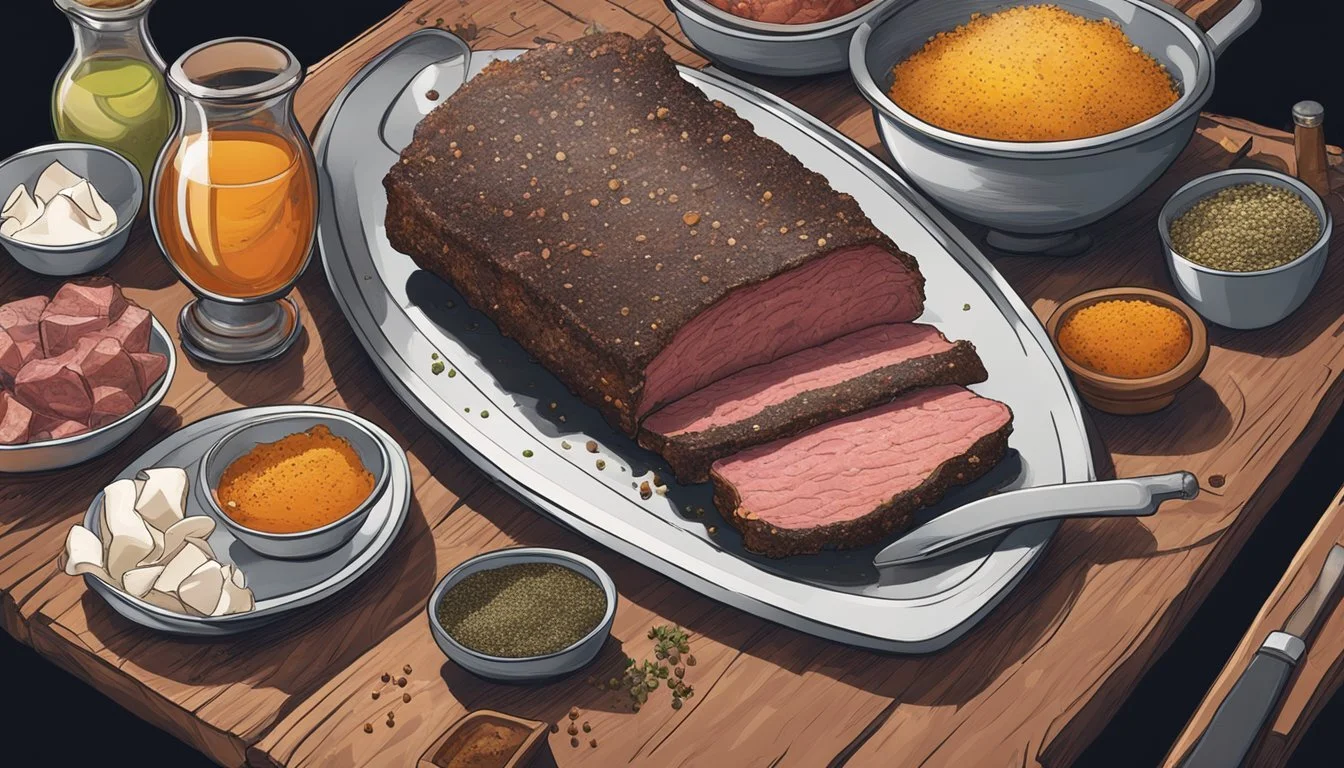How to Ferment Pastrami
Mastering the Art of Flavor Development
Making pastrami involves a process of preservation and flavoring meat, traditionally beef brisket, (What wine goes well with beef brisket?) that has its origins in the culinary traditions of Eastern Europe. The journey of transforming beef into pastrami includes curing, which imbues the meat with a salty, savory flavor and a texture that can withstand smoking. Smoking the pastrami introduces a depth of flavor that is punctuated by the characteristic smoky notes, which are a signature of this beloved deli meat.
For the enthusiastic home cook, creating homemade pastrami is an endeavor that invites an exploration into the art of meat smoking and curing. It starts with selecting a quality piece of beef brisket, which is then cured with a mixture of salt, sugar, and curing salts. This process not only seasons the meat but also acts to preserve it, creating an environment that is unfavorable for bacteria to grow. After the curing process, the meat is coated with a blend of coriander, black pepper, mustard seed, and other spices, giving pastrami its distinct crust and flavor profile.
The culmination of making pastrami is the smoking step. The cured and seasoned beef is slowly smoked at low temperatures, which tenderizes the meat while infusing it with the smoky essence from the wood chips used. This technique not only cooks the pastrami but also imparts a rich, aromatic flavor that distinguishes it from other cured meats (What wine goes well with cured meats?). The patience required for this process rewards the maker with a finished product that epitomizes the fusion of complex flavors and textures synonymous with smoked pastrami.
Selecting the Meat
When fermenting pastrami, the selection of meat is crucial as it influences both the flavor and texture of the final product. The choice of cut and the quality of the meat set the foundation for an exceptional pastrami.
Choosing the Right Cut
The cut of beef most traditionally used for pastrami is the brisket. This is because brisket has an ideal balance of meat and fat, which contributes to the texture and moisture of the pastrami. There are two main parts of the brisket: the flat and the point.
The Flat: The flat is the leaner part of the brisket. It's known for having a more uniform thickness, which can provide a consistent curing and smoking process.
The Point: The point contains more intramuscular fat and connective tissue. This section often yields more flavor due to the fat content but can be trickier to cure and smoke evenly due to its irregular shape.
For pastrami, it's recommended to select a cut that includes both the flat and the point. However, for a leaner pastrami, one might opt for a brisket flat alone.
Another choice is the navel cut, which is fattier than brisket and has a robust beef flavor, making it an excellent option for pastrami. It is a cut from the plate section and contains a significant amount of fat, which needs to be trimmed appropriately.
Irrespective of the specific cut, it is essential to look for a fat cap of about ¼-inch thick on one side of the brisket. This layer of fat helps to keep the meat moist during the curing and smoking process, without preventing the seasoning from penetrating the meat.
Understanding Meat Quality
The quality of the meat is equally as important as the cut. Choosing high-quality beef with signs of good intramuscular fat (marbling) will contribute significantly to the flavor and tenderness of the pastrami.
Grain-Fed vs. Grass-Fed: Grain-fed beef typically has more intramuscular fat, which can result in a richer flavor and tender texture. Conversely, grass-fed beef may be leaner with a more pronounced beef taste.
USDA Grade: Look for a USDA grade that indicates the level of marbling in the meat. USDA Prime has the highest level of marbling, followed by USDA Choice and Select. Prime or Choice grades are best for pastrami due to their fat content and tenderness.
Sourcing the meat from a reputable butcher or supplier can ensure that it is fresh and of good quality. They will also properly store and handle the meat, which is vital to prevent contamination and ensure safety during the fermenting process.
Preparing the Brine
The brine is a crucial component for fermenting pastrami, as it cures and imbues the meat with flavor. Proper ingredient mixing and maintaining the brine for the appropriate duration are key to successful pastrami.
Mixing the Ingredients
For the brine, one combines water and ice in a large container, ensuring the temperature is low to keep the meat safe during curing. They typically add kosher salt, which acts as a base for the brine. Curing salt is also essential; Prague Powder #1, also known as curing salt #1, is a common choice. It contains sodium nitrite and is used in a ratio of 1 teaspoon per 5 pounds of meat.
The spices and aromatics form the character of the pastrami and include:
Pickling spice: A blend that may contain ingredients such as bay leaves, cinnamon, mustard seeds, and allspice.
Garlic: provides a pungent depth.
Brown sugar or dark brown sugar: adds a hint of sweetness to balance the flavors.
Coriander seeds, black peppercorns, and mustard seeds: are often lightly toasted to enhance their flavors before adding them to the mix.
They thoroughly combine these with the water and ice to make sure the salts and sugars are fully dissolved, resulting in a uniform mixture that will cure the meat evenly.
Brining Duration
The meat, traditionally beef brisket for pastrami, pre-cured as corned beef, is submerged in the prepared brine. It is essential to ensure that the meat is completely covered. If necessary, one can weigh down the meat with a plate or a sealed bag filled with water to keep it submerged.
The duration of the brine is typically 5-7 days. During this time, the brisket is kept refrigerated and it's important to turn the meat in the brine at least once per day to ensure even curing. The brine not only cures but also tenderizes and flavors the meat, laying the foundation for the characteristic taste of pastrami.
Applying the Rub
The application of the rub is key to creating the complex flavor profile associated with pastrami, combining spices for the ideal crust and penetration of flavors.
Making the Pastrami Rub
A traditional pastrami rub comprises a carefully selected blend of spices that together create a robust flavor. To prepare the rub:
Coriander and black peppercorns: These should be freshly ground for the most potent flavor. They are the backbone of the rub, giving pastrami its characteristic crust.
Brown sugar: Adds a slight sweetness that balances the spices.
Ground spices:
Mustard seeds: These can be left whole for texture or ground for a more intense flavor.
Garlic powder and onion powder: They provide a savory depth.
Paprika: Offers a subtle smokiness and color.
Ground ginger: Provides a warm, spicy note to the mix.
For consistency, all ground spices should be sifted together to ensure even distribution. Mixing these spices in the proper proportions is critical to achieving the ideal pastrami flavor.
Coating the Meat
Once the pastrami rub is ready, the next step is to coat the meat:
Begin by patting the brisket dry with paper towels to ensure proper adhesion of the rub.
Generously apply the rub onto all surfaces of the meat, using hands to massage the mixture into any crevices to ensure even coverage.
It's essential to cover the meat thoroughly; the rub acts as a curing agent that will penetrate the meat during the smoking process to infuse flavor.
After the meat is coated, it can be wrapped and left to cure, allowing the rub's flavors to deeply penetrate before smoking.
By following these steps with attention to detail, one can ensure the pastrami develops a flavorful crust and has a harmonious balance of spices.
Curing the Meat
The curing process is integral to developing the pastrami's signature flavor and texture. An effective cure relies on maintaining precise temperature control and using a well-crafted curing brine.
Curing Basics
The foundation of curing meat, such as beef for pastrami, begins with a curing brine. This solution typically consists of water, salt, sugar, and assorted spices. Here is a basic outline for assembling the curing brine:
Water: Use cold water to better dissolve the curing ingredients and ensure an even distribution over the meat.
Salt: A critical component, it works to draw moisture out, preserving the meat.
Sugar: Balances the salt's harshness and aids in the flavor profile.
Spices: The choice of spices can be varied, but classic pastrami spices include coriander, black pepper, and sometimes garlic or bay leaves.
Once the brine is prepared, the meat should be fully submerged. If necessary, a weight can be used to keep the meat under the liquid. The container with the meat and brine is then covered and placed in the fridge.
Temperature Control
Consistent temperature during the curing stage is essential to prevent bacterial growth and ensure the meat cures safely and effectively. The fridge provides the ideal cold environment, typically maintained around 34-38°F (1-3°C). The meat should remain in the curing brine for a total time that varies depending on the recipe's specifics and the meat's size, usually ranging from 5 to 7 days. Throughout this time, it’s advised to turn the meat occasionally to promote an even cure.
During the entire curing process, the temperature of the fridge should be periodically checked to ensure it remains within the safe curing range. A stable temperature contributes significantly to the quality and safety of the cured beef, preparing it for the subsequent smoking phase.
Smoking the Pastrami
Before diving into the specifics of smoking pastrami, one must consider the choice of wood and the type of smoker, as well as the meticulous process of monitoring the smoke throughout the cooking time to achieve the perfect balance of flavor and texture.
Choosing Wood and Smoker
The selection of wood is a critical decision in smoking pastrami. For a classic pastrami flavor, oak is the recommended wood, known for providing a robust smoke without overpowering the meat. When preparing the smoker, whether a dedicated smoker or a converted charcoal grill, it is essential to manage the fire to maintain a steady smoker temperature.
Recommended Wood: Oak
Smoker Setup:
Maintain a steady supply of wood chips or chunks for consistent smoke production
Use a water pan to stabilize the smoker's temperature and add moisture
The smoker should reach and uphold a temperature around 250°F. This ensures a slow and even cooking process that is pivotal for the perfect pastrami.
Monitoring the Smoke
Consistent monitoring of the smoker temperature is key to achieving the quintessential pastrami bark and ensuring the internal temperature of the meat reaches the desired level. Utilize a reliable smoker thermometer to check the internal environment without frequently opening the smoker door, which may cause fluctuations in temperature and smoke levels.
Smoker Temperature: Aim for 250°F
Internal Temperature: Most recipes recommend smoking until the pastrami reaches an internal temperature of around 150°F, although some variations suggest smoking until it reaches 205°F for a different texture.
Throughout the smoking process, adjusting the air vents may be necessary to control the smoke and temperature, ensuring an ideal atmosphere for the pastrami to develop its characteristic flavor and crust. It is beneficial to refer to trusted sources, such as smoking-meat.com, for detailed guidance on smoking meats.
Steaming the Pastrami
Steaming is a crucial step in the pastrami-making process, ensuring the meat becomes tender and retains its juices. The right setup and monitoring of internal temperature are vital for the perfect finish.
Setting Up the Steaming Process
One begins by positioning the pastrami within a steam setup, typically using a steamer basket over boiling water. It's important that the pastrami doesn't touch the water directly; steam should cook the meat. Covering the meat with foil can improve the steaming process, trapping the moisture close to the pastrami.
Checking Doneness
A meat thermometer is an indispensable tool for checking the doneness of pastrami. The aim is to reach an internal temperature of about 195°F to 205°F. This range ensures that the collagen within the meat has broken down sufficiently, rendering the pastrami tender without overcooking it.
Slicing and Serving
When serving pastrami, the texture and flavor are greatly enhanced by the method of slicing and the accompaniments chosen for the plate. This section will detail the correct approach to cutting pastrami and the recommended practices for presenting it to your guests or for your own enjoyment.
The Proper Way to Slice
The key to slicing pastrami lies in its preparation. One should always slice pastrami across the grain to ensure each piece is tender and showcases the meat's marbling. The slices should be thin, aiming for a thickness akin to a credit card for optimal texture. Pastrami is easier to slice when cold, as the gelatin within the meat has solidified, providing a firmer texture that holds together during the slicing process.
Best Practices for Serving
When serving pastrami, it should be done so with consideration to the harmony of flavors and textures. Here are specific guidelines:
Rye Bread: A classic pastrami sandwich is served on rye bread, which offers a robust flavor and sturdy foundation.
Mustard: Spicy brown or Dijon mustard are traditional condiments that complement the rich taste of the meat.
Sides: Consider serving with pickles or coleslaw to add a refreshing contrast to the savory, smoky pastrami.
Deli-style: For a true deli experience, pastrami can be served piled high on rye, complemented by a pickle on the side.
Pastrami Sandwiches: Quality pastrami sandwiches strike a balance between the meat, bread, and minimal condiments to allow the flavors of the pastrami to prevail.
In serving pastrami, it is essential to ensure that the sides and condiments do not overshadow the main attraction but rather enhance the overall enjoyment of the dish.
Storing and Reheating
Proper storage and reheating techniques are crucial for maintaining the quality and taste of pastrami. They make sure that the meat retains its moisture and flavor when served.
Storage Tips
One should store pastrami in the fridge to extend its shelf life and maintain safety. It is recommended to wrap the pastrami in aluminum foil or place it in an airtight container to prevent it from drying out. The ideal temperature for refrigeration is below 40°F. When storing, take note of the following:
Portion Size: Pre-slice the meat for easier serving sizes later on.
Calories: Avoid additional high-calorie condiments if storing for health-conscious consumption.
Servings: Plan servings based on consumption to avoid unnecessary reheating which can impact the quality.
Reheating Without Losing Moisture
To reheat pastrami without losing its moisture, the method of gentle heating is key. It must be done in a way that doesn't dry out or toughen the meat. The following methods are recommended:
Oven Method:
Preheat the oven to 325°F.
Wrap the pastrami in foil to seal in moisture.
Reheat for 10-15 minutes, checking periodically.
Stove Top Method:
Add 3-5 tablespoons of water or beef stock to a pan.
Once simmering, add the pastrami.
Cover and heat for 1-2 minutes on medium-low heat.
Each method aims to trickle heat through the pastrami, ensuring it remains succulent and ready to eat.
Health and Safety Considerations
In fermenting pastrami, one must prioritize safety by understanding the risks associated with improper fermentation and by adhering to best practices. The process involves precise control of bacteria and the use of curing agents like pink salt.
Understanding the Risks
Fermentation of pastrami is a bacteria-driven process where beneficial bacteria, such as Lactobacillus, are encouraged to grow to prevent spoilage from harmful pathogens. Improper fermentation can lead to the growth of harmful bacteria causing foodborne illnesses. Pink salt, containing sodium nitrite, is often used in the curing mix to inhibit the growth of botulism-causing bacteria. However, it must be used in the correct proportions as it is toxic in high quantities.
Beneficial bacteria: Enhances safe fermentation
Harmful bacteria: Can cause foodborne illness if allowed to grow
Pink salt (sodium nitrite): Inhibits harmful bacteria but must be used cautiously
Best Practices
To ensure safety when fermenting pastrami:
Always use a meat probe to monitor internal temperatures, ensuring the meat consistently stays within a safe temperature range to prevent bacterial growth.
Utilize a meat injector for even distribution of the brine, which helps to prevent areas of the meat from remaining unseasoned and susceptible to bacteria.
Strictly adhere to recommended proportions of pink salt and other curing agents to ensure efficacy and safety.
Temperature Control:
Safe range: Keep the meat within 40°F - 140°F to avoid the "danger zone" where bacteria rapidly grow.
Curing Agents:
Proportions: Follow recipe guidelines for pink salt and other curing agents to ensure safety.
Additional Tips and Tricks
Crafting the perfect pastrami involves careful attention to flavor development and efficient use of preparation time. Employing specific techniques can elevate the taste and reduce the hours spent on the process.
Enhancing Flavor
When fermenting pastrami, the key to unlocking deep, rich flavors lies in the quality of the spice rub and the smoking method. For the spice rub, one should focus on a blend including coriander, black pepper, and mustard seeds. These are often complimented by garlic powder, paprika, and other pickling spices which can be toasted to intensify their taste.
In terms of smoking, hickory or applewood chips impart a traditional flavor to the pastrami. The meat should be smoked with a fat cap to ensure moisture and taste infusion. To enhance the flavor, it is imperative that one maintains the correct temperature:
205°F - target temperature for finished pastrami.
155°F - recommended internal temperature before wrapping in foil, if the technique is used.
The use of Prague Powder #1, a curing salt, is crucial for both the safety and the development of pastrami's characteristic pink hue and savory flavor.
Reducing Prep Time
Time management is vital in the pastrami-making process. While it cannot be rushed, certain steps can streamline prep time without sacrificing quality.
Batch Preparation: Prepare and mix the spice rub in large quantities for future use.
Curing: The brisket should be kept in the brine for 5-7 days, but one can rotate multiple briskets through the same curing solution to maximize efficiency.
Brisket Selection: Choosing brisket with a uniform thickness can decrease total cook time, as it cooks more evenly.
Optimizing smoker usage by cooking multiple briskets simultaneously will not only save time but also ensure better use of resources. By focusing on these methods, one can effectively reduce both preparation and total cook time of pastrami.
Exploring Variations
Creating a unique pastrami involves experimenting with various meats and spice blends. This section explores different ways to innovate traditional pastrami recipes.
Trying Different Meats
Traditional pastrami typically uses corned beef which is beef brisket that has been brined. However, culinary enthusiasts can try other cuts such as chuck roast or the beef plate for varying textures and flavors. Chuck roast offers a richer, marbleized meat experience, while the beef plate, situated just below the rib primal cut, provides a fattier alternative that can enhance the pastrami's juiciness.
Corned Beef: The classic choice, offering a balance of fat and lean meat.
Chuck Roast: Leaner than brisket, but with generous marbling for a tender bite.
Beef Plate: Typically fattier, it creates a richer pastrami.
Experimenting with Spice Blends
Pastrami's distinctive taste comes largely from its spice blend. Starting with a base of pickling spices, cooks can create a variety of flavor profiles. A standard pastrami rub includes ingredients like mustard powder or yellow mustard seeds, coriander, black pepper, and sometimes sugar for a hint of sweetness.
Here's an example of a basic pastrami spice blend:
Coriander Seeds: Provides warm, nutty notes.
Mustard Powder: Adds tanginess and heat.
Black Peppercorns: Responsible for the sharp, piquant flavor.
One can adjust the proportions or add unexpected spices to personalize their pastrami seasoning. Exploring with spices and seasoning not typically associated with this dish, such as smoked paprika or cloves, can result in a unique and signature flavor.
Pastrami in Different Cultures
Pastrami, as a culinary delicacy, varies globally, adapting to local tastes and gastronomic histories. While its roots are in Eastern European Jewish cuisine, it is now a global phenomenon, with each culture adding its own twist to the traditional preparation of this cured and smoked meat.
Pastrami Around the World
Eastern Europe: In its birthplace, pastrami is traditionally made from beef brisket or shoulder. The meat is brined, seasoned, smoked, and steamed, resulting in the classic dish known worldwide. It remains a staple in Romanian and Jewish cuisine.
United States: The American version of pastrami was popularized in New York City delis. It's typically served on rye bread and is known for its distinctive smoky flavor and tender texture. In the U.S., pastrami gained significant popularity, often associated with deli culture and city life.
Turkey: Turkish pastirma is another dry-cured meat featuring fenugreek, which gives it a unique taste profile. This variation is more commonly made from beef or water buffalo and is seasoned with a distinctive paste called çemen.
St. Patrick's Day: Though pastrami is not a traditional Irish food, it sometimes finds its way onto celebratory menus, acting as an alternative to the classic corned beef, particularly in the United States during this holiday.
Incorporating Local Flavors
Asia: Some Asian countries incorporate local spices into the curing mixture, embracing flavors like star anise, soy sauce, or Sichuan peppercorns, highlighting the region's preference for aromatic and bold tastes.
Middle East: Countries in the Middle East may prepare pastrami-like dishes with a variety of meats, including lamb and goat, using local spices like za'atar and sumac to infuse regional flavors.
Amazon and Store-Bought Variations: Ready-to-eat pastrami can be purchased from a wide range of retailers, including online platforms like Amazon. These store-bought options make the delicacy more accessible worldwide, offering a convenient way to enjoy pastrami without the need for homemade preparation.
Pairing with Sides and Drinks
When enjoying pastrami, the right accompaniments can enhance its flavors. The selection of side dishes and beverages can either complement or contrast the rich, smoky taste of the meat.
Classic Side Dishes
Pastrami is often served with a variety of side dishes that highlight its unique flavor profile. Here are some classic sides that pair well with pastrami:
Coleslaw: A crunchy, tangy slaw can provide a refreshing contrast to the rich meat.
Potato Salad: Creamy potato salad with a hint of mustard complements the spices of pastrami.
Pickles: The briny sharpness of pickles cuts through the fattiness of the meat.
Sauerkraut: Its sourness pairs well with the smoky flavors, particularly when served on rye bread.
Beverage Pairings
A careful selection of beverages can elevate the pastrami eating experience. Here are recommended pairings:
Beer: A robust lager or pilsner can cleanse the palate between bites of the spiced and smoked meat.
Wine: A light-bodied red wine, such as a Pinot Noir, suits the bold flavors without overpowering them.
Soda: A classic deli pairing, a crisp soda offers sweetness and effervescence to complement the savory pastrami.
Resources and References
When attempting to ferment pastrami, it is essential to consult dependable resources and references that provide detailed guidelines and community wisdom. These help ensure the success of the fermenting process and provide insights from experts and enthusiasts alike.
Books and Guides
"Smoking Meat: The Essential Guide to Real Barbecue" by Jeff Phillips is an invaluable resource for any level of cook interested in smoking meat, including pastrami. It offers step-by-step tutorials and a variety of recipes. Moreover, the book is available for purchase on Amazon, providing ease of access to readers worldwide.
For those particularly seeking in-depth tutorials on the art of making pastrami, there are specific guides available online as well as in print formats. These guides cover everything from selecting the right cuts of meat to the nuances of the curing and smoking processes.
Online Communities
The Smoking-Meat.com forums are an excellent online community where one can seek advice, share experiences, and find support from fellow smoking enthusiasts. Members range from professionals to amateur cooks, all contributing to a rich repository of knowledge.
Additionally, platforms such as Reddit and Facebook host various groups and pages dedicated to smoking meats where members often share their methods, pictures, and results of fermenting pastrami, which can also be quite educational for newcomers seeking practical advice from experienced individuals.

